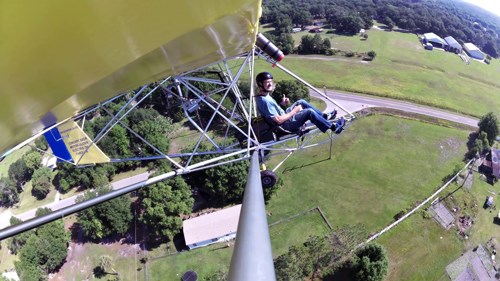Electric-powered aircraft: good for composites suppliers
Electric-powered flight is nascent, but the promise is real, as is the opportunity for composites fabricators and suppliers.

Electric-powered Zigolo, by Aeromarine, in flight.
Recently, an electric-powered ultralight aircraft, the Zigolo by Aeromarine (Lakeland, Fla., USA) flew at the Sun ’n’ Fun airshow held in Florida during the first week of April. This may or may not be noteworthy — the flying demonstrator, says Aeromarine’s head Chip Erwin, isn’t even made of composites at this point; to get it ready to fly to the show, the tubular frame was made of aluminum. Erwin, a composites aircraft specialist, says that parts of the Zigolo are going to transition to composites going forward. What is remarkable is that electric aircraft have matured to the point that they’re readily available for sale — the electric Zigolo kit will sell for around $20,000, says Erwin.
The Zigolo joins an ever-longer list of aircraft powered by electricity, generated via solar cells or batteries, often with better performance than electric cars. We’ve reported extensively on the Solar Impulse 2 aircraft, a gossamer craft that has flown in Europe and the U.S. (see news story here: www.compositesworld.com/blog/post/sun-composites-long-duration-solar-powered-flight). Airbus Group flew its E-Fan electric technology demonstrator in Bordeaux, France on April 25 to showcase electric propulsion, which the company hopes will lead to reduction in aircraft noise and emissions, to meet upcoming European guidelines (News story here: www.compositesworld.com/news/airbus-demonstrates-electric-e-fan-aircraft) and the company is definitely looking into larger electric powerplants for commercial flight.
Pipistrell (Ajdovščina, Slovenia) has developed a four-seat electric plane, a customized Taurus G4, which won NASA’s Green Flight Challenge in 2011 with a stunning performance of more than 200 miles nonstop at an average speed of more than 100 mph, delivering 403.5 passenger seat miles per gallon equivalent. In comparison, a typical Boeing 737 delivers 88, or a Toyota Prius, 100. A 2012 article in Scientific American (“Can Electric Aircraft Take to the Skies?” by Umair Irfan and ClimateWire) argues that looming taxes and fees on carbon emissions, and the price of aviation fuel, is driving the electric technology push. Penn State aerospace engineering professor Jack Langelaan says that electric engines are very efficient at converting stored energy to mechanical energy, three times an internal combustion engine, but energy density of a battery is a factor of 70 less than gasoline. So, the extra weight (of batteries) needs to be countermanded by an extremely light airframe.
The takeaway here is that is electric aircraft are at the tipping point, and moving into the mainstream. As they develop, composite materials will be critical to offsetting battery weight and light-weighting the structure as much as possible — and it’s likely a growing opportunity for our industry.
Related Content
-
Welding is not bonding
Discussion of the issues in our understanding of thermoplastic composite welded structures and certification of the latest materials and welding technologies for future airframes.
-
Plant tour: Joby Aviation, Marina, Calif., U.S.
As the advanced air mobility market begins to take shape, market leader Joby Aviation works to industrialize composites manufacturing for its first-generation, composites-intensive, all-electric air taxi.
-
Plant tour: Spirit AeroSystems, Belfast, Northern Ireland, U.K.
Purpose-built facility employs resin transfer infusion (RTI) and assembly technology to manufacture today’s composite A220 wings, and prepares for future new programs and production ramp-ups.













